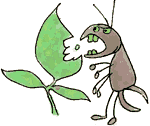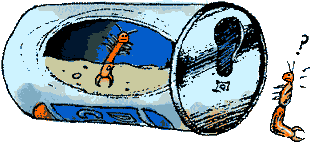Earwigs
Earwigs are a common sight in gardens all around the world, from Aachen to Zyryanka. They are among the oldest insects on our planet and have not evolved much, except to become smaller. Despite appearing to run toward you, they're not actually aggressive. They're simply seeking the nearest dark place to hide, like under your shoe!
- Earwigs are about 1 inch (2.54 cm) long with a hard, reddish-brown shell and pincers at the tail end.
- They don't bite, but the pincers on their tails can give a nasty pinch if they get trapped under you.

- If your plants are getting chewed to pieces and the roots are shredded, there may be earwigs in your garden.
- Flip over a rock or some mulch, and if you see a bunch of them scurrying away, then you definitely have an earwig problem.
- Use a floating row cover to keep your plants safe underneath. Lay it early in the season before earwigs start to get out and roam.

You can make an earwig trap using empty margarine tubs or soda cans.
- Half-fill the margarine tub or soda can with used, soapy dishwater.
- Turn it on its side and bury the trap halfway in a shady spot in your garden or around the yard.
- If you're allowed, use flat beer instead, and your traps will also catch slugs.
- After a couple of days, empty and refill the trap with used dishwater or beer.
- Alternatively, you can mix 1/4 teaspoon (1.2 mL) dishwashing soap with 3 cups (710 mL) of water in a spray bottle.
- Squirt the earwigs with the mixture when you find them hiding in damp places and under rocks.
If you have a severe problem with earwigs, try this non-chemical method:
- Place a damp, rolled-up newspaper in the garden each night.
- This will attract hundreds of earwigs in a heavily infested area.
- In the morning, dump the newspaper into a large bucket of hot, soapy water to kill the earwigs.
- Dispose of the wet newspaper in your compost pile.
Fascinating Facts!
- Earwigs are insects that belong to the order Dermaptera, which means 'skin wings'.
- Despite their name, earwigs do not crawl into people's ears and lay eggs in their brains.
- Earwigs have two pairs of wings, but they rarely fly. They use their wings to glide short distances.
- There are over 2,000 species of earwigs, and they can be found all over the world, except for in Antarctica.
- Earwigs are nocturnal insects and feed on a variety of things, including other insects, plants, and decomposing organic matter.
- Some species of earwigs are known for their maternal care. The mother will stay with her eggs and young and protect them from predators.
- The largest earwig on record was 3 inches (7.6 cm) long and was found in South America. Most earwigs are much smaller, around 0.5 to 1.5 inches (1.3 to 3.8 cm) long.
bugs
caring
|



